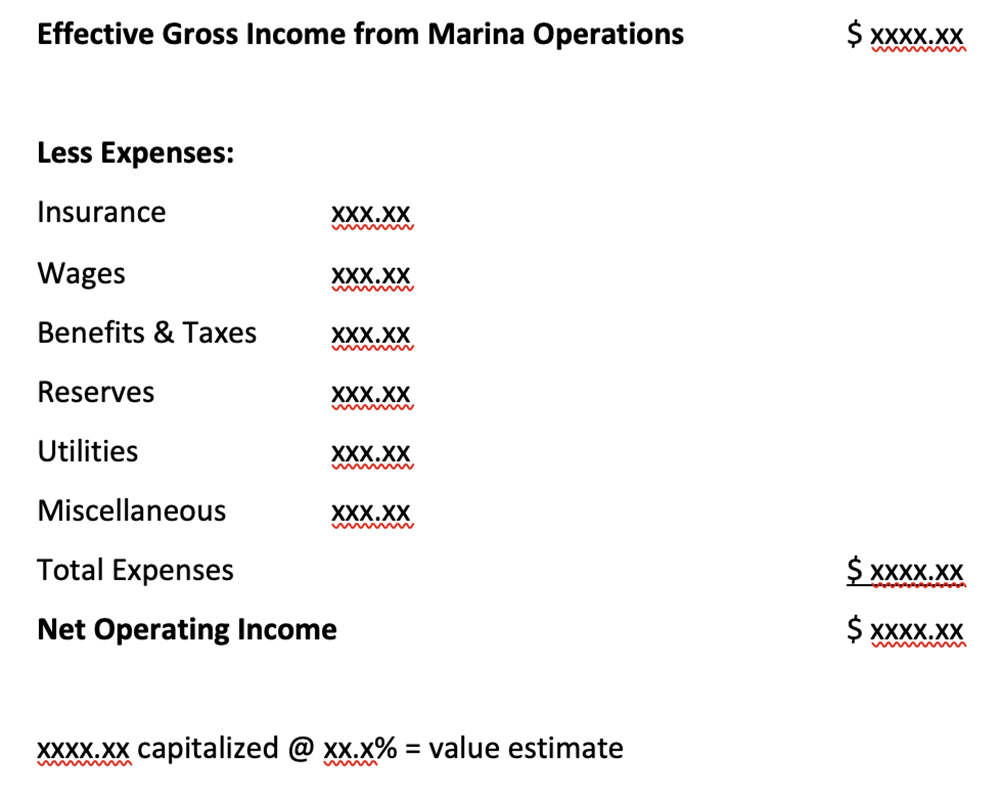
The valuation of marinas is one of the most challenging appraisals to perform respective of the fact that they often contain a lot of moving parts, so to speak. This article intends to simplify the process by outlining a succinct methodology for both the appraiser and operator alike.
What often comes to question from realtors, assessors, appraisers and operators is what is how does one draw the line between valuing the real estate and the marina business itself. The real estate in the case of a marina essentially includes the value of the building components, storage area (typically used for storing boats) and the value of the slips themselves. The business elements of a marina include sales of parts, fuel, boat repairs, food and sundry items which are unrelated to the real estate. These are the elements that would be valued by a business valuation expert.
Methodology – a model for valuation
Income Elements would include:
• Slip Rentals
• Boat Storage Rental Income
• Economic value of the various buildings (typically assigned a market rental rate)
Expense Elements would include:
• Reserve for replacement for each of the marina physical elements which would include the slips, buildings on site, the fixed docks, bulkhead and maintenance of the basin area. Marinas, being positioned on the water and are often subject to harsh weather conditions which can accelerate the depreciation of the various structures. The appraiser should estimate the replacement cost of the various structures, determine an appropriate depreciable life and essentially establish a sinking fund for monies that need to be put aside annually to account for the replacement of the various elements.
• Labor Costs are often an element that one would associate with the business end of a valuation however, in order to run, service and maintain the various physical elements, manage the boat yard, provide accounting for the physical elements, staff is needed. Depending upon the size of the boatyard, one would typically account for having a general manager, a bookkeeper and at least a couple skilled laborers that will maintain the yard, the docks and the services that are provided to the boaters, which typically include: water, electric and cable. The skilled laborers are a perfect example where the physical asset and the maintenance of such are inseparable.
• Utility Costs would cover the basic utilities supplied to the slips, ie: water, electric and sometimes cable which are typically supplied to the slips. Other utilities might also be provided to an administration building and/or buildings used for storage and repair of boats.
• Insurance, providing for hazard and liability for the boatyard and site improvements as well as workman’s compensation for the minimum staff required on site.
• Miscellaneous Expenses could include: trash removal (as boaters tend to generate a good deal of trash), landscaping, advertising, telephone, office supplies, professional services (typically associated with engineering and environmental testing of basin sediments), yard supplies (items such as decking for docks, cleats, hoses, brackets used on the docks, electrical supplies and floatation devices that sometimes need to be replaced). Other elements that are related to the collection of yard fees such a bank charges, collections and filings are all directly supportive of the on-site infrastructure.
A simple Income Approach to Value model could look like below:

The In’s and Outs of Marinas
Marinas are one of those types of properties that are heavily regulated by government agencies, in this case and more prominently by the DEEP in Connecticut. The policing of businesses that use or come in contact with environmentally hazardous materials is at an all-time high. In the case of marinas the biggest environmental element to deal with is the approval of removal, and then dumping of spoils from the boat basin. The term “spoils” refers to the sediment that is dredged from the bottom of the boat basin.
Each application with the DEEP to dredge material from a boat basin must be accompanied by engineering studies and tested samples of the material to be dredged. This is a process that has become more onerous and quite costly over the past twenty years with marina operators sometimes spending tens of thousands of dollars just for the testing and approval process. Unfortunately, without a boat basin with a reasonable depth to accommodate boats there is no marina. Further complicating the process has been the frequency of storms in recent years, namely Hurricane’s Irene and Sandy which sometimes dumped many yards of sediment material in basins. This appraiser has worked with a couple marinas in Southern Connecticut that had, just prior to the hurricanes finished dredging their basins, only to have material dumped in their basins again, essentially starting the testing and dredging process all over.
Recent Trends impacting the Marina Industry
Positive Trends: According to the Connecticut DEEP, the number of boats registered in Connecticut during 2019 was 91,791 boats, down from the peak in 2006 when 112,319 boats were registered. COVID brought about a resurgence in the boating industry with both old and new boaters seeking a “safe” recreational activity.
• Boat registrations in Connecticut nearly doubled in 2020
• According to the National Marine Members Association boat sales during 2020 were 320,000 units, up 13% from the year before
• During 2018 the Connecticut Marine Trades Association successfully lobbied reducing the sales tax on boats from 6.35% to 2.99%.
Negative Trends: The dumping of spoils has only become more expensive over the past twenty years with dredging and dumping costs rising precipitously. D & D costs today typically range between $30.00 and $35.00 per cubic yard while the average cost just six years ago was closer to $20.00 per cubic yard. For marinas that have an ongoing problem with accretion of material in their boat basins, this could be the nail in the coffin for some operators. At the very least, it is impacting operating expenses in a material way, reducing the net income to most marina operations.
The recent lawsuit between the State of Connecticut and the State of New York about dumping spoils in Long Island Sound was settled this past year, but the settlement has yet to change the cost of dredging and dumping of material.
Utility Costs have soared with Eversource (a major supplier of electricity in Connecticut) increasing its rates 13.8% this past year. Given that most marinas supply electricity to their boat slips, this has become an operating expense of concern.
Marina operation and valuation has become more challenging and the operation of marinas most certainly less profitable for many. On the down side, dredging and environment costs have impacted some marinas greatly (especially those who need to dredge more frequently) COVID has brought about a resurgence in boat sales and slip rentals over the past year, with the majority of the marina operators surveyed reporting record occupancy. Overall, the outlook is positive for both the marina and boating industry, with operators and boat sellers alike enjoying the best market in years.
Marc Nadeau, SRA, is a certified general appraiser and president of the Connecticut Chapter of the Appraisal Institute.








